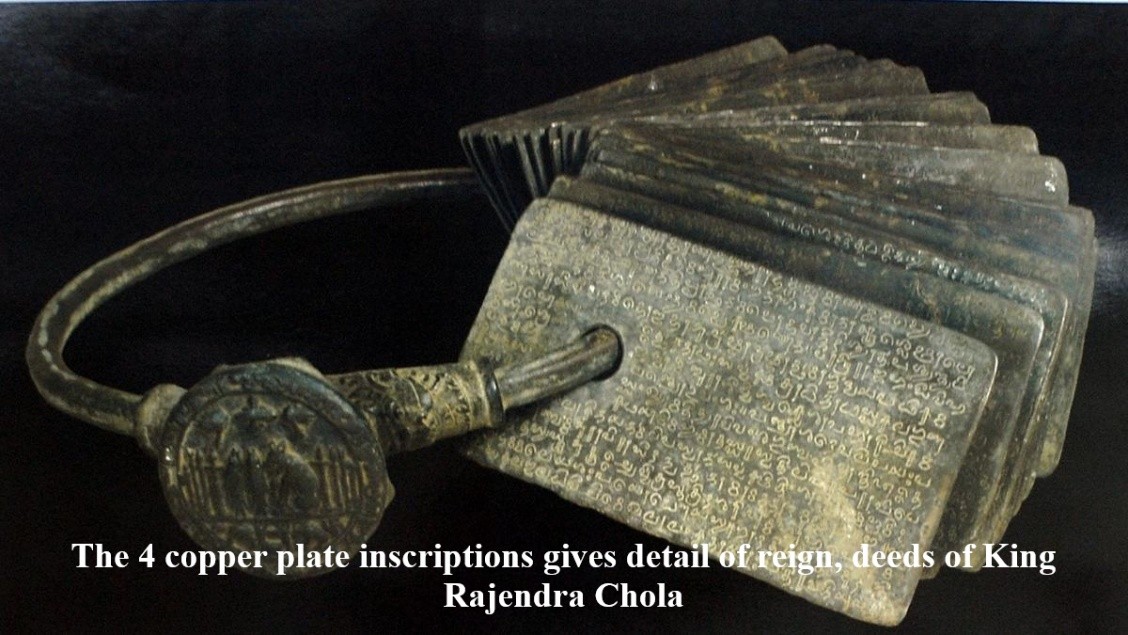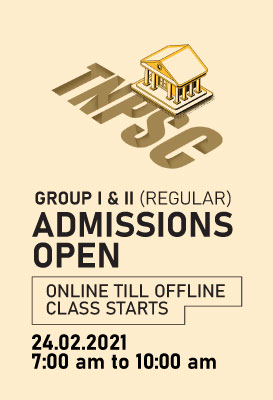PREVIOUS
Copper plate inscriptions about Rajendra Chola
July 29 , 2025
11 hrs 0 min
67
0
- Among the most valuable records from Rajendra Chola’s time are four sets of copper plate inscriptions discovered at different locations.
- The Tiruvalangadu Copper Plates, the Karanthai Copper Plates, the Tirukkalar Copper Plates, and the Esalam Copper Plates highlight the Chola lineage, temple endowments, and military expeditions.
- Rajendra Chola I, the son of Raja Raja Chola I, expanded the frontiers of the Chola empire beyond the Indian subcontinent.
- Not only military conquests across South and Southeast Asia but also generous land grants and temple patronage marked his reign (1012-1044 CE).
- These inscriptions shed light on Chola lineage, temple endowments, and military expeditions.
- The books, Sozhar Ceppedugal by Ve. Mahadevan and Ka. Sankaranarayanan (Tamil University, Thanjavur) and Sozhar Kaala Ceppedugal by former IAS officer M. Rajendran (Akani Publishers), provide insights into copper plate inscriptions of various Chola kings, especially Rajendra Chola.
Tiruvalangadu Plates
- The Tiruvalangadu Copper Plates were first mentioned in the Annual Report of the Archaeological Survey of India (ASI) for 1903-04.
- The plates were later published in Volume III of South Indian Inscriptions by epigraphist Rao Bahadur H. Krishna Sastri.
- This set comprised 31 copper plates, with the first 10 inscribed in Sanskrit and the remaining 21 in Tamil.
- The inscription was divided into three parts: the Sanskrit section, the first Tamil section, and the second Tamil section.
- According to epigraphist V. Venkayya, the Tamil parts were considered earlier, with the Sanskrit section possibly added later.
- The second Tamil section referred to the sixth regnal year of Rajendra Chola I, placing it around 1018 CE.
- The plates were linked together by a circular copper seal with royal emblems.
- It is including two fly-whisks on either side of a royal parasol, a tiger (the Chola emblem), two fishes (the Pandya emblem), a bow (the Chera emblem), a boar (the Chalukya emblem), a Swastik, and two lamps.
- These plates recorded the royal order of Rajendra Chola gifting Palaiyanur village to the Tiruvalangadu Shiva temple (in Tiruvallur district).
Karanthai Plates
- The Karanthai Copper Plates were discovered in a field at Puthur village near Ammapettai in Papanasam taluk of Thanjavur district.
- Initially referred to as the Puthur Copper Plates, they were renamed after being preserved by the Karanthai Tamil Sangam at Karunthattankudi, near Thanjavur, in the late 1940s.
- They had reportedly been discovered six decades earlier on land belonging to Sevu Pandiyan.
- The set comprised 57 copper plates, weighing 111.73 kilograms, linked by two large copper rings, one of which was broken.
- The remaining ring bore the royal seal featuring the emblems of the Cholas, the Pandyas, the Cheras, and the Chalukyas, along with lamps, the royal parasol, and fly-whisks.
- Several of the 54 Tamil plates bore the word ‘Thiribu’.
- It was referencing the gifted village — Thiribhuvana Mahadevi Chaturvedi Mangalam — named in honour of Rajendra Chola’s mother.
Tirukkalar Plates
- The Tirukkalar Copper Plates were discovered at the Parijathavaneswarar Temple at Tirukkalar.
- It is a village nearly 20 kilometres southeast of Mannargudi, in Tiruvarur district.
- The temple yielded a set of five copper plates inscribed in Tamil and 23 stone inscriptions, all from the Chola period.
- The earliest among them was dated to around 1030 CE (the 18th regnal year of Rajendra Chola).
- These plates detail a land grant made to the Mahadevar Temple at Tirukkalar.
- It was part of the ‘Purangkaranbai Nadu’ in the ‘Arulmozhi Deva Valanadu’.
Esalam Plates
- The Esalam Copper Plates were discovered at Esalam near Tindivanam on July 11, 1987, during the renovation of a Shiva temple.
- Esalam was the first site where all three types of historical artefacts were unearthed together.
- A similar triad was later found at Tiruindalur (in Mayiladuthurai district) in 2010.
- Tamil Nadu State Department of Archaeology studied the plates and confirmed that they belonged to the reign of Rajendra Chola.
- They were dated to 1036 CE (his 24th regnal year).
- Among the bronze icons was a statue of Sarva Siva Pandithar, believed to be Rajendra Chola’s guru.
- These plates, engraved on both sides, were bound by a copper ring with a seal bearing the emblems of the Cholas, the Pandyas, the Cheras, and the Chalukyas, along with lamps, the royal parasol, and fly-whisks.
- The inscriptions opened with Rajendra Chola’s genealogy in Sanskrit.
- The Tamil portion detailed his land grants to the temple built by Sarva Siva Pandithar and listed the regions conquered during his reign.
- His ‘meikeerthi’ (royal eulogy) said the famous Vidyadhara Torana was brought from Kadaram (Kedah in Malaysia).

Leave a Reply
Your Comment is awaiting moderation.


